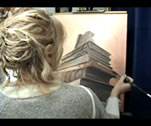This section provides a list of techniques, materials, and common references that are frequently used in the design and decorative painting profession.
Unprepared walls can ruin the best design or faux work. One needs to verify the stability of the wall substrate, patch and repair cracks, holes, buckling drywall tapes and so forth. Your finish will make up no default, unless you have selected a pattern as busy as an Oriental rug. Otherwise, they will be magnified by a new application of paint. Also, the wall ground has to be clean, free of grease and dust, to insure a better bond to the new coat. In addition, the base coat has to be thoroughly dry before coating it with a glaze. In a bathroom project, one needs to be twice as vigilant because of the ambient humidity that will remain behind the fresh latex paint (if latex is used) until it is completely cured; a premature glazing may cause the base coat to bubble.
It has fallen into disgrace for many years, yet it seems to be back in style, with modern and hip patterns. It is a wonderful way to treat walls with a handsome or original specimen. Old elegant wallpapers are worth being cleaned and re-pasted where needed. Zuber wallpapers for instance, Chinese hand painted ones, and historical products are ageless and should be preserved. You may fall upon rare finds at auction, and these same rolls can be pasted with special glue allowing an easy removal from the walls if you decide to take them with you or sell them. If hung in a bathroom or a kitchen, finish can protect them against humidity and allow their cleaning. Wallpapers introduce diversity into your premises and respond more adequately to the function of the room. Since their pattern is often available in the matching fabric, it is easy to recreate a cozy and visually relaxing ambiance.
This includes doors, windows, architraves, wainscots, pillars, baseboards, cornices, sills and so forth.: anything made of wood that finishes a space. Woodwork is the poor parent of the decor, because priority is often given to walls. If your design scheme is to create a neutral room, the woodwork will be understated; on the contrary, to organize a decor, the woodwork will structure your project. To this effect you may select strong colors that will set the walls, as a frame enhances a painting. Or you may have recourse to a frieze on the ceiling molding, around double doors or passageways, or else, marbling or graining part or all of the trims. Trim colors can team up with the furniture upholstery and draperies, giving more character to a room and allow it to take on life.






